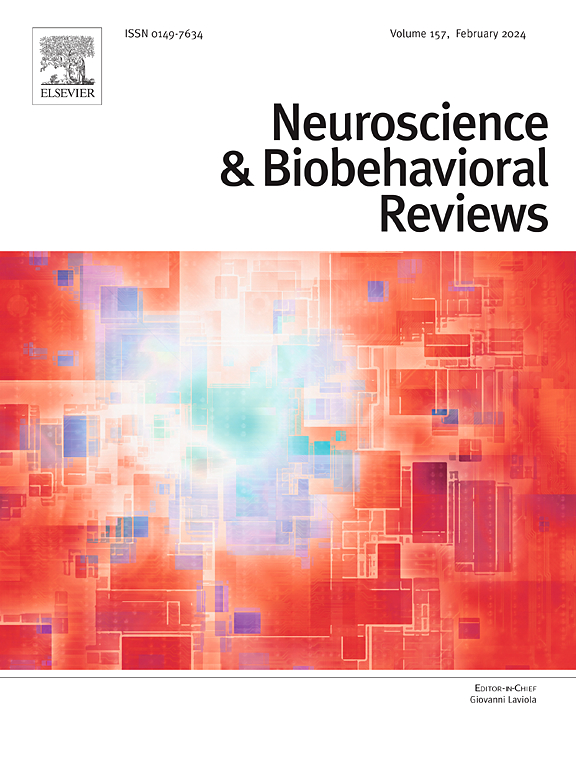自闭症社会运动协调的神经关联:fNIRS研究的系统回顾和荟萃分析
IF 7.9
1区 医学
Q1 BEHAVIORAL SCIENCES
引用次数: 0
摘要
本研究旨在通过功能近红外光谱(fNIRS)研究自闭症谱系障碍(ASC)个体如何处理社会运动协调,重点是联合动作及其神经相关,并将其与神经正常(NT)个体进行比较。11项研究进行了分析,其中9项纳入了荟萃分析。结果发现顶叶下小叶(IPL)和颞上沟(STS)是解释关节动作时皮层激活的组间差异的重要调节因子。具体来说,ASC患者IPL激活增加,STS激活减少,表明对运动加工的依赖增加,编码和整合社会相关信息的参与减少。虽然脑间同步(IBS)的综合效应大小没有统计学意义,但描述性分析显示ASC中互惠加工减少的趋势,特别是在预测和协调伴侣的精神状态方面,这得到了颞顶交界处(TPJ) IBS减少的支持。此外,自闭症严重程度对行为和神经结果的视觉检查显示出明显的趋势。与中度至重度症状的个体相比,轻度症状的个体表现出不同的神经行为关联,这表明症状的严重程度影响神经处理如何支持关节活动。这些发现强调了神经系统参与ASC个体联合行动的差异,这取决于任务类型和自闭症严重程度,并强调了个人内部和人际处理之间的区别。通过整合这些发现,本研究提供了一个更综合的视角,将ASC的社会运动协调作为一个复杂的、多维的过程。本文章由计算机程序翻译,如有差异,请以英文原文为准。
Neural correlates of social motor coordination in autism: A systematic review and meta-analysis of fNIRS studies
This study aimed to provide a comprehensive overview of how individuals with autism spectrum condition (ASC) process social motor coordination, focusing on joint action and its neural correlates, as examined through functional near-infrared spectroscopy (fNIRS) in comparing to their neurotypical (NT) counterparts. Eleven studies were analyzed, with nine included in the meta-analysis. The results identified the inferior parietal lobule (IPL) and superior temporal sulcus (STS) as significant moderators explaining group differences in cortical activation during joint action. Specifically, individuals with ASC showed increased IPL activation and reduced STS activation, indicating a greater reliance on kinematic processing and diminished engagement in encoding and integrating socially relevant information. Although the pooled effect size for inter-brain synchrony (IBS) was not statistically significant, descriptive analyses showed a trend toward reduced reciprocal processing in ASC, particularly in predicting and aligning with a partner’s mental states, as supported by decreased IBS in the temporoparietal junction (TPJ). Furthermore, a visual inspection of behavioral and neural outcomes by autism severity exhibited distinct tendencies. Individuals with mild symptoms demonstrated different neural-behavioral associations compared to those with moderate-to-severe symptoms, suggesting that symptom severity influences how neural processing supports joint action. These findings highlight the differential involvement of neural systems in joint actions among individuals with ASC depending on task type and autism severity, and emphasize the distinction between intra- and inter-personal processing. By integrating these findings, this study offers a more integrative perspective on social motor coordination in ASC as a complex, multi-dimensional process.
求助全文
通过发布文献求助,成功后即可免费获取论文全文。
去求助
来源期刊
CiteScore
14.20
自引率
3.70%
发文量
466
审稿时长
6 months
期刊介绍:
The official journal of the International Behavioral Neuroscience Society publishes original and significant review articles that explore the intersection between neuroscience and the study of psychological processes and behavior. The journal also welcomes articles that primarily focus on psychological processes and behavior, as long as they have relevance to one or more areas of neuroscience.

 求助内容:
求助内容: 应助结果提醒方式:
应助结果提醒方式:


